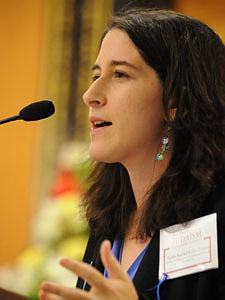At the beginning of Parshat Bamidbar, God asks Moses to “take a census of the whole Israelite community”[1] in the desert as a prelude to the people’s eventual entry into the Land of Israel. The Hebrew word for community, edah, is most often used to mean the entire nation;[2] but here, rather than serving as a comprehensive detailing of the entire people, the census has a narrow focus. Those to be counted are “every male…from the age of twenty years up, all those in Israel who are able to bear arms.”[3] The snapshot of the Israelites that Moses is being asked to take includes only those adult males who can serve in the army. Everyone else just doesn’t count.
Looking at the scope of the census, including the all-male list of tribal leaders who assist Moses in conducting the count,[4] Rabbi Margaret Moers Wenig asks:
Where are the women?…These women also left Egypt and reached this spot in the wilderness. They too collected manna and helped build the Tabernacle. They were there all right, but the omission of their names renders them invisible… All those who are too young or too old to bear arms or serve as active members of the priesthood aren’t worth mentioning by name or number.[5]
By emphasizing their absence, Wenig invites us to picture those the census leaves faceless. How can we imagine the wandering Israelites in the desert without thinking about the women carrying children, the teenagers becoming the first generation to enter adulthood in freedom, or the elders who had dreamed about living to see the Land of Israel? Those who are marginalized by the counting are still essential to the story. Wenig also encourages us to explore our own experiences of marginalization—times when we were rendered invisible by our religion, gender or race. The experience of not being among those who count allows us to empathize with the counter-narrative of the parshah.
The experience of being rendered invisible and voiceless is very real for members of marginalized groups around the globe today, who often struggle to obtain basic public services and rights accorded to the general population. Among these, more than 650 million people live with disabilities,[6] for which many face significant hurdles in receiving access to healthcare, adequate education and employment.
The discrimination faced by people with disabilities is especially acute in developing countries, where many societies consider these conditions shameful. The disabled there often face significant prejudice that prevents their full integration into societies that prefer to keep them hidden, and many are confined to their homes by families afraid of being shamed.[7] According to the International Labor Organization, unemployment rates among the disabled can reach as high as 80 percent in some countries;[8] and even those individuals who are able to enter society are limited by a lack of handicapped-accessible transportation and public places.
A guiding principle of AJWS’s grantmaking is to empower marginalized populations to become agents of change, and AJWS funds several grassroots organizations around the world that work with people living with disabilities. One of these is MUSAS (Mujeres que Inspiramos Cambios, or “Women Who Inspire Changes”), the only grassroots network in Peru dedicated to advocating for equal opportunities for disabled women. MUSAS works to address discrimination, violence, poverty and unemployment by providing trainings for women living with disabilities, using radio programs to reach and educate those isolated in rural communities and collaborating with other local organizations to advocate within the Peruvian Congress. One participant in MUSAS’s programs explained what it was like to escape her invisibility:
As a result of the workshops, I have regained my space, broken my limits and done things that I couldn’t have previously imagined. In our dance workshop, I dance and move. I can’t move my whole body physically, but I close my eyes and I can move my feet and feel the music, and I see myself dancing. I have changed. I think we have all changed. We have broken many limits to be independent.
In addition to supporting organizations like MUSAS, we can take steps domestically to make sure that no one is rendered invisible by prejudice or policy. We should encourage our members of Congress to ratify the Convention on the Rights of Persons with Disabilities, which President Obama signed on July 30th, 2009, but which Congress has yet to ratify. And as we sensitize ourselves to issues facing those with disabilities in the Global South, we must also be aware of issues of accessibility and prejudice in our home communities, making sure that public spaces are accessible for all to use and that we create an environment of inclusion and acceptance.
Every person, regardless of physical ability, must be counted and afforded basic rights. Unlike the limited edah of the census in Bamidbar, our global edah must be a complete community, with the image of God in every person made visible. It is up to us to ensure that everyone counts.
[1] Numbers 1:2.
[2] Milgrom, Jacob. The JPS Torah Commentary: Numbers. The Jewish Publication Society: Philadelphia, 1989, p. 4, comment on Numbers 1:2.
[3] Numbers 1:2-3.
[4] Numbers 1:5-15.
[5] Rabbi Margaret Moers Wenig. “Being Invisible.” Sermon preached at Beth Am, the People’s Temple, 20 May 1988.
[6] “Some Facts about Persons with Disabilities.” United Nations Web Services Section, 2006. http://www.un.org/disabilities/convention/facts.shtml The United Nations defines disabilities as any restriction or lack (resulting from an impairment) of ability to perform an activity in the manner or within the range considered normal for a human being. This definition includes both mental and physical disabilities, including those that are invisible. U.N. Decade of Disabled Persons 1983-1992. World Programme of Action Concerning Disabled Persons. New York: United Nations, 1983.
[7] “Taking Jewish Disabilities Awareness Month Global.” American Jewish World Service, 20 February 2009. http://www.ajws.org/who_we_are/news/archives/features/taking_jewish_disabilities_
awareness_month_global.html
[8] “Some Facts about Persons with Disabilities.” United Nations Web Services Section, 2006. http://www.un.org/disabilities/convention/facts.shtml

